
Argyll and Bute is one of 32 unitary authority council areas in Scotland and a lieutenancy area. The current Lord-Lieutenant for Argyll and Bute is Jane Margaret MacLeod. The administrative centre for the council area is in Lochgilphead at Kilmory Castle, a 19th-century Gothic Revival building and estate. The current Council leader is Councillor Robin Currie, a councillor for Kintyre and the Islands.
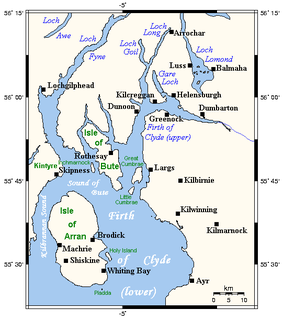
The Firth of Clyde is the mouth of the River Clyde. It is located on the west coast of Scotland and constitutes the deepest coastal waters in the British Isles. The firth is sheltered from the Atlantic Ocean by the Kintyre peninsula, which encloses the outer firth in Argyll and Ayrshire. The Kilbrannan Sound is a large arm of the Firth of Clyde, separating the Kintyre Peninsula from the Isle of Arran. Within the Firth of Clyde is another major island – the Isle of Bute. Given its strategic location at the entrance to the middle and upper Clyde, Bute played a vital naval military role during World War II.

Dunoon is the main town on the Cowal peninsula in the south of Argyll and Bute, Scotland. It is located on the western shore of the upper Firth of Clyde, to the south of the Holy Loch and to the north of Innellan. As well as forming part of the council area of Argyll and Bute, Dunoon also has its own community council. Dunoon was a burgh until 1976.

Cowal is a peninsula in Argyll and Bute, in the west of Scotland, that extends into the Firth of Clyde.

Loch Long is a body of water in Argyll and Bute, Scotland. The Sea Loch extends from the Firth of Clyde at its southwestern end. It measures approximately 20 miles (32 km) in length, with a width of between 1 and 2 miles. The loch also has an arm, Loch Goil, on its western side.
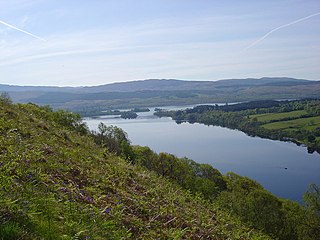
Loch Awe is a large body of mostly freshwater in Argyll and Bute, Scottish Highlands. It has also given its name to a village on its banks, variously known as Loch Awe or Lochawe. There are islands within the loch such as Innis Chonnell and Inishail.

Loch Fyne, is a sea loch off the Firth of Clyde and forms part of the coast of the Cowal peninsula. Located on the west coast of Argyll and Bute, Scotland. It extends 65 kilometres (40 mi) inland from the Sound of Bute, making it the longest of the sea lochs in Scotland. It is connected to the Sound of Jura by the Crinan Canal. Although there is no evidence that grapes have grown there, the title is probably honorific, indicating that the river, Abhainn Fìne, was a well-respected river.

Kirn is a village in Argyll and Bute in the Scottish Highlands on the west shore of the Firth of Clyde on the Cowal peninsula. It now forms part of the continuous habitation between Dunoon and Hunters Quay, where the Holy Loch joins the Firth of Clyde. It originally had its own pier, with buildings designed by Harry Edward Clifford in 1895, and was a regular stop for the Clyde steamer services, bringing holidaymakers to the town, mostly from the Glasgow area.

Loch Striven is a sea loch extending off the Firth of Clyde, and forms part of the Cowal peninsula coast, in Argyll and Bute, Scotland.

Colintraive is a village in Argyll and Bute, Scotland. Once the site where cattle were swum across the narrows to the Isle of Bute, the MV Loch Dunvegan — a ferry operated by Caledonian MacBrayne — now provides a link to the island.

Clachaig; is a small settlement, on the Cowal peninsula in Argyll and Bute, Scotland. It is located on the B836 road between the Holy Loch and Loch Striven, the hamlet is just over a mile long. Clachaig is a Gaelic word meaning 'stone place'.
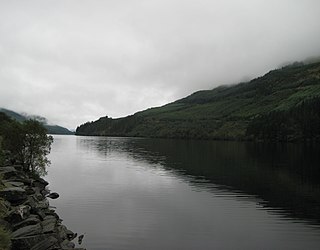
Loch Eck is a freshwater loch located on the Cowal peninsula, north of Dunoon, Argyll and Bute, Scotland. It is seven miles long. Along with Loch Lomond, it is the only naturally occurring habitat of the Powan (fish). The loch also has salmon, sea trout, brown trout and arctic charr.
The Affric / Beauly hydro-electric power scheme for the generation of hydro-electric power is located in the western Highlands of Scotland. It is based around Glen Strathfarrar, Glen Cannich and Glen Affric, and Strathglass further downstream.
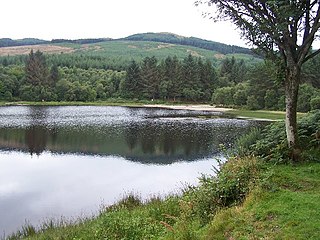
Bishop's Glen Reservoir also known as Dunoon Reservoir used to be the source for drinking water for the town of Dunoon on the Cowal peninsula, Argyll and Bute, Scotland, a function now satisfied via Loch Eck. Records show that this impounding reservoir was created before 1880. The Balgaidh Burn is the main inflow and outflow.

Inveruglas is a hamlet on the west shore of Loch Lomond, fairly near the north end of the loch and is within the Loch Lomond and The Trossachs National Park. It is situated on the A82 trunk road, connecting Glasgow to Inverness. It is within the historic county of Dunbartonshire, and since 1996 it has been part of the Argyll and Bute council area.

Glen Lean is on the Cowal peninsula in Argyll and Bute, Scotland. It is an obvious glacial-formed glen, with near vertical sides along part of the glen. It runs from the head of the Holy Loch in the east to the head of Loch Striven in the west. The only hamlet in the glen is Clachaig. The Little Eachaig River flows out of the glen, joining the River Eachaig and flows into the Holy Loch. The Tarsan Dam is the other notable feature in the glen.

Loch Loskin is a freshwater loch in Ardnadam, Argyll and Bute, Scotland. The outflow from the loch is the Milton Burn, which winds its way through Dunoon to the Firth of Clyde. The A885 from Sandbank known as the "High Road" locally passes the loch.
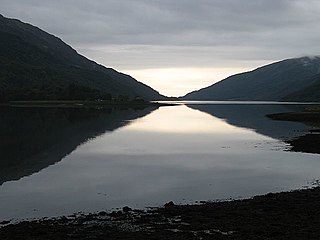
Ardtaraig is a hamlet lying at the head of Loch Striven on the Cowal peninsula, Argyll and Bute, West of Scotland. The hamlet is on the single track B836 road.

















